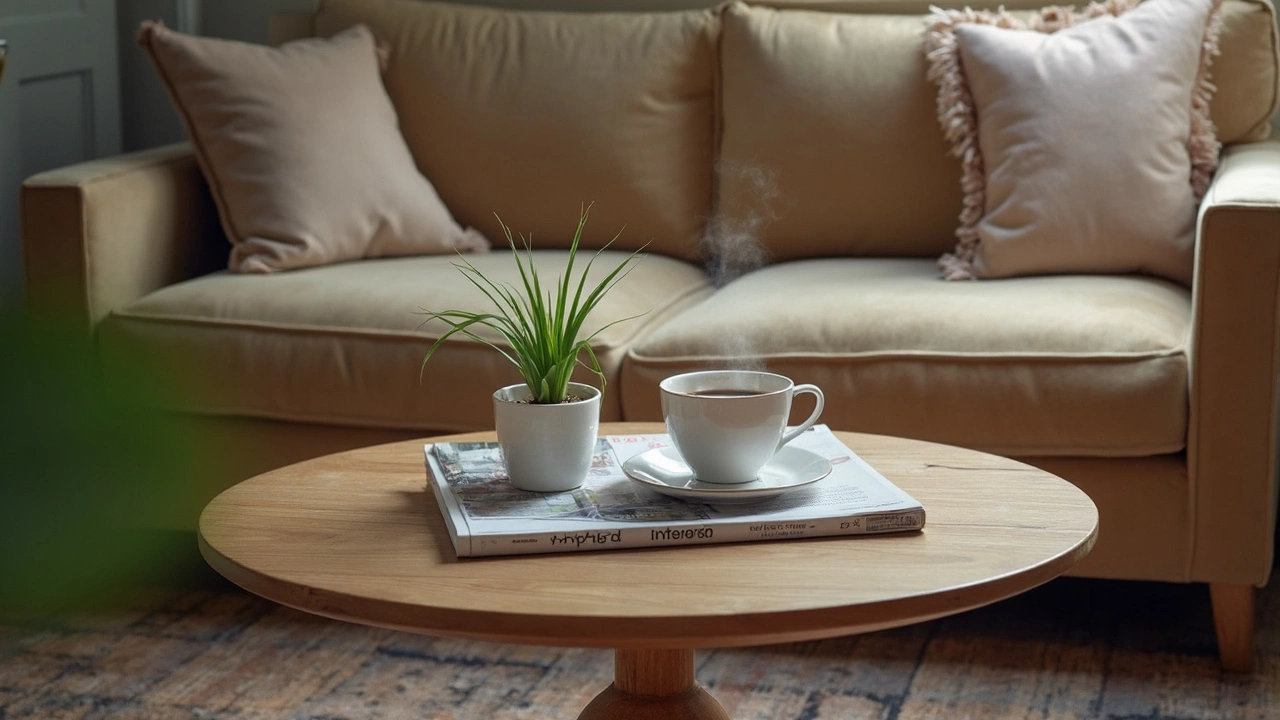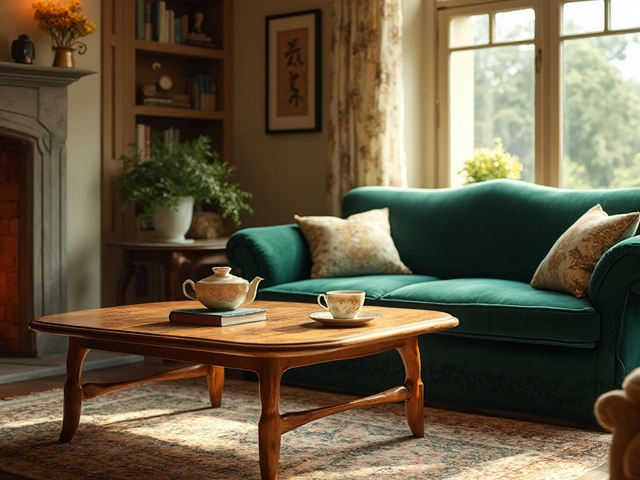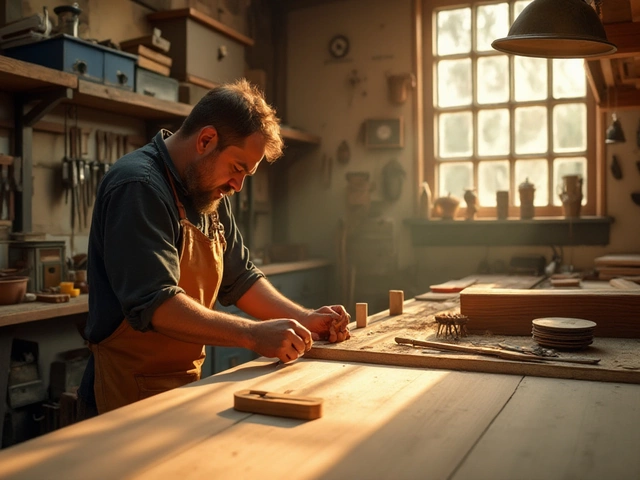Ever brought home a coffee table, slid it in front of your couch, and thought, 'Is this right?' Trust me, you’re not alone. Getting the perfect height isn’t just about looks—it actually matters for comfort and how you use the space. Most people want a table that sits about level with the couch seat. But what if it’s a bit taller? Say, two inches higher?
A two-inch difference might sound tiny, but you’ll notice it when you go to place your mug, prop up your feet, or reach for the TV remote. It could make things easier if you use your table for eating or working. On the flip side, it might feel awkward for guests expecting the ‘classic’ look and function. And if you’ve got little kids like my Brielle sprinting around, the edge of the table becomes more noticeable at that height.
- Why Coffee Table Height Matters
- Exploring the 2-Inch Difference
- Functionality Vs. Style
- Everyday Life: Real-World Examples
- Common Mistakes and Fixes
- Smart Furniture Shopping Tips
Why Coffee Table Height Matters
People don’t often think about the height of a coffee table until it’s actually in the living room. But once you start living with it, the importance jumps out pretty quick. Your coffee table is no small background detail – get the height wrong, and you’ll notice it every day. It messes with how you set down drinks, how relaxed people feel, and even how the whole room looks. The right height can pull everything together or make your space look a bit odd and uncomfortable.
Let’s get concrete. The coffee table height most furniture guides recommend is about even with your couch cushions, usually 16 to 18 inches high. Most couches sit around 17 to 19 inches. Designers stick to this rule because it lines up with how people use their tables—for snacks, laptops, or just kicking up their feet. If you go higher or lower, normal activities like grabbing a slice of pizza or playing a board game get a bit clumsy.
Here’s a simple chart that breaks down some common heights and how they stack up:
| Table Height | Couch Seat Height | Comfort Level |
|---|---|---|
| 14" | 17" | Too Low – Awkward reach |
| 17" | 17" | Ideal – Easy access |
| 19" | 17" | Feels Tall – Can work for eating, less cozy |
Height doesn’t just affect comfort—visual balance matters too. If your coffee table is too high, the whole setup looks off, almost like someone swapped in the wrong furniture by mistake. Too low, and it feels like the table is missing its purpose.
When you’ve got young kids in the mix, table height can become a safety thing. A higher table edge is right at face-level for toddlers, and a too-short table just turns into a tripping hazard for adults. Strange as it sounds, even how much space you’ve got in your room comes into play—a taller table can make a small living room feel crowded.
If you want a setup that works for real life, pay close attention to the numbers. Don’t just eyeball it. Grab a tape measure next time you rearrange the furniture, and you’ll see just how much this small detail shapes your day-to-day comfort.
Exploring the 2-Inch Difference
This is where things get interesting. Most design guides say your coffee table should be the same height as your couch seat, or up to an inch lower. So, what happens if you go two inches higher instead? It's not a major design crime, but it does have real effects on how the space works and feels.
The average couch seat height is about 17 to 18 inches. Coffee tables usually range between 16 to 18 inches in height. When the table is two inches taller than the couch, you get a surface that's easier for grabbing snacks or typing on a laptop. But visually, it can throw off the eye line, especially if your living room is small. Most people notice not because it’s ugly, but because it just feels a tad unusual.
As home organizing pro Emily Henderson puts it, "A coffee table that's slightly higher than your sofa seat works well for functionality, but if you go too high, it can look off-balance and mess with the room's flow."
This extra height can be a real plus in certain situations, though. People who use their table as a workstation or a dining space appreciate less bending. Older adults or folks with back pain often prefer a taller coffee table because it’s just easier to reach.
Here's a quick table to sum up the impact of that 2-inch difference:
| Aspect | Standard Height | 2 Inches Higher |
|---|---|---|
| Comfort (Seated) | Feels natural, easy to reach from seat | Better for eating/typing, may feel high for lounging |
| Visual Balance | Matches furniture lines | Table stands out more |
| Kid Safety | Below knee level for most kids | Edges are closer to kids’ faces |
| Practical Use | Classic look, great for entertaining | Works well for eating/working |
If your top priority is coffee table height for meals or laptops, going up those two inches isn’t a problem. But for relaxed, traditional living spaces, it’s good to stick close to the sofa seat level.
Functionality Vs. Style
There’s always a balancing act between function and looks when it comes to your living room setup. For most folks, the main goal is that their coffee table height works for daily life—whether you’re setting out snacks, flipping magazine pages, or helping the kids with homework. So, what actually changes if your coffee table is two inches higher than your couch seat?
First up, comfort. Standard couch seat height usually hovers around 18 inches. Most design pros will tell you to stick to a coffee table that’s about level with the seat or no more than 1 to 2 inches lower. But some trendier, modern homes are flipping the script with slightly taller tables. A table two inches higher than the couch sits right at about 20 inches—and, truth is, there are pros and cons:
- Reaching Comfort: If anyone in the house eats at the table or works from the sofa, a taller surface makes it way easier to reach your stuff. No hunching over!
- Look and Proportion: Most people are used to seeing tables level with the cushions, so a taller table might stand out—sometimes good, sometimes not. Super sleek or mid-century tables can pull this off.
- Family Safety: For kids that are still learning how to run in a straight line, higher edges on a table can mean more scraped knees and bonked heads. Definitely something to consider.
- Legroom: Taller tables usually don’t change the amount of space under the table, but they can make kneeling or stretching out a bit more awkward.
Here’s a quick comparison of what you gain and lose if your table is taller:
| Aspect | Standard (Level Table) | 2 Inches Higher |
|---|---|---|
| Reaching Ease | Average | Better for eating/working |
| Style Familiarity | Classic, expected | Modern, more noticeable |
| Risk for Kids | Lower | Higher cuts/scrapes |
| Versatility | Works with all styles | Best in certain designs |
If your vibe is all about clean lines and bold, modern looks, that 2-inch difference could work in your favor. But if comfort and safety are the big priorities, matching up the table and couch height still wins for most families. No setup is one-size-fits-all. It all depends on what you actually do on your couch and how much "wow factor" you want in your living room.

Everyday Life: Real-World Examples
If you’re still on the fence, it helps to see how a coffee table that’s 2 inches higher than your couch plays out in real living rooms. Here’s what actually happens in day-to-day use.
Let’s say your couch seat height is the typical 18 inches. That makes your coffee table about 20 inches off the ground. Some people love this because it puts things like laptops, snacks, and drinks closer to hand—no more awkward bending. I know one mom who uses her slightly tall table to line up crafts for her kids, and it makes cleaning way easier since there’s less stooping down.
But not everyone’s a fan. If you host game nights with friends on the floor, those extra 2 inches can make it less cozy for leaning or sitting around the table. And for shorter adults or kids, propping up feet gets awkward—a problem Brielle reminded me of while watching movies with her legs dangling.
To give you a snapshot, check out these real examples:
| Setting | Couch Seat Height | Coffee Table Height | Feedback |
|---|---|---|---|
| Small Apartment | 18" | 20" | Easy for remote work, feels a little high when lounging |
| Family Room | 17" | 19" | Good for snacks, less comfy for board games |
| Open Living Space | 19" | 21" | Looks sleek, kids bump legs often |
So what’s the takeaway? A table that's a couple inches higher makes sense if you use it as a work surface or snack spot more than a footrest. But if comfort for lounging is your main thing, you might prefer the table level with the couch. When you’re deciding what fits best, just picture how you actually use that space every day.
Remember, the coffee table height isn’t just about style—it really changes how you live in your living room.
Common Mistakes and Fixes
Plenty of folks run into trouble when picking out or placing a coffee table, especially around the issue of height. One big mistake is not measuring the seat height of your couch before shopping for a table. Guessing or eyeballing usually backfires. Even that slight two-inch difference above the couch can become more noticeable when you actually use the space.
Another slip-up is ignoring how you use your table. Maybe you mostly snack, play cards, or let your kids draw there. In that case, a taller coffee table might be perfect. But for kicking your feet up or hosting friends for a movie night, a table two inches above the seat height can feel awkward or out of place.
Here’s what helps fix these common mistakes:
- Coffee table height tip: Before you buy, grab a tape measure. Check the distance from the floor to the top of your couch cushion where you usually sit—measure when nobody’s sitting on it. Bring that number to the store or compare it online.
- If your table’s already too high, try these fixes: swap in shorter legs (sometimes possible with attachable legs sold at hardware stores), use a decorative tray with rubber pads to bring frequently-used items closer to you, or even raise your couch slightly with low-profile furniture risers (handy if your couch is super low).
- If you picked a table purely for looks, check if you like how it functions in daily life. Ask your family (kids give the most honest feedback) how they actually use it. A quick change—like re-positioning the table a few more inches away from the couch—can help minimize the height difference and make it feel less awkward.
Don’t forget, living rooms are rarely perfect. If your setup feels a bit off, there’s almost always an easy, budget-friendly way to tweak it.
Smart Furniture Shopping Tips
Nobody wants to lug the wrong coffee table home, realize it’s a tad too tall, and start doubting their choices. Let's talk about how to pick the right fit the first time, especially if you're on the fence about those extra two inches.
First rule? Measure. Take a quick height check of your couch’s seat—most are about 17-19 inches high, but models can vary. Jot that down on your phone before shopping. When you’re at the store or scrolling online for a coffee table height, compare those numbers. Standard coffee tables run between 16-18 inches high, but there are loads of outliers.
Second, always try to visualize how you’ll use the table. Are you mostly setting down drinks? Love to put your feet up? Or do you treat it as a spot for family board games? Juggling all those jobs means the difference between "just right" and "awkward".
- Sit on your couch and mimic reaching for something on an imaginary table. Notice your arm's angle and comfort.
- Bring painter’s tape and outline tables’ height on your floor if you’re at home. Or stack books to the ideal height.
- If the table doubles as a workspace for laptops or snacks, a couple extra inches can actually be a win.
If you’re shopping online, check the product return policies. Around 30% of buyers end up returning furniture because it isn’t the expected size or comfort, according to Wayfair’s 2024 customer report (see below).
| Brand | Avg. Return Rate (%) | Reason: Wrong Height (%) |
|---|---|---|
| Wayfair | 30 | 15 |
| IKEA | 17 | 10 |
| West Elm | 22 | 12 |
Don’t trust only stock photos—read user reviews for nuggets about "too tall" or "perfect fit." Sometimes the crowd really knows best. As interior designer Emily Henderson says,
"A coffee table shouldn’t be an afterthought. Spend five minutes sizing it right and your living room just works—no awkward reaching or knee-bumping."
Finally, when in doubt, bring home a table with adjustable height or legs. You get flexibility without the second-guessing.



